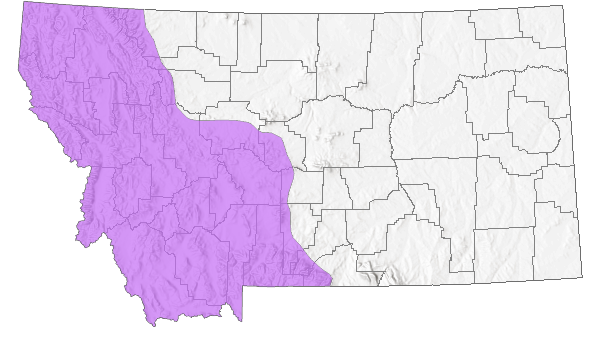View in other NatureServe Network Field Guides
NatureServe
Montana
Utah
Wyoming
Idaho
Wisconsin
British Columbia
South Carolina
Yukon
California
New York
Variable Bentgrass - Agrostis variabilis
Native Species
Global Rank:
G5
State Rank:
S3S4
(see State Rank Reason below)
C-value:
4
Agency Status
USFWS:
USFS:
BLM:
External Links
State Rank Reason (see State Rank above)
Agrostis variabilis occurs in the alpine and subalpine meadows and talus slopes of western Montana. Populations appear to be stable as it grows in relatively common habitats, does not appear to be reproductively limited by its biology, and the locations of older and newer observations does not suggest a change in distribution within western Montana.
- Details on Status Ranking and Review
Range Extent
ScoreF - 20,000-200,000 sq km (~8,000-80,000 sq mi)
Comment99,250 square kilometers
Area of Occupancy
ScoreE - 26-125 4-km2 grid cells
CommentPlant occurs in 41 of the 30,590 4x4 square-kilometer grid cells that cover Montana.
Number of Populations
ScoreC - 21 - 80
Comment49 observations
Number of Occurrences or Percent Area with Good Viability / Ecological Integrity
ScoreC - Few (4-12) occurrences with excellent or good viability or ecological integrity
Comment4 observations assumed to have 'good viability' based on descriptor of being 'common'.
Environmental Specificity
ScoreC - Moderate. Generalist or community with some key requirements scarce
CommentAgrostis variabilis occurs in alpine, subalpine meadows, forests, and talus slopes which are fairly common in Montana.
General Description
PLANTS: A short bunch forming perennial grass with a congested panicle inflorescence. Stems are 10-20(-30) cm tall.
LEAVES: Mostly basal, with blades 3-7 cm long and (0.5-)1-2 mm wide. When young blades are flat but often become involute (rolled) with age. Ligules are 1–3 mm long.
INFLORESCENCE: A panicle which is often purplish hued and 2-6 cm long. Branches are somewhat appressed to the main stem (rachilla), thus appearing dense. Branches branch again, but only near their bases. Spikelets are short, 2-2.3mm long, ovate to lanceolate in outline, and greenish or often purplish hued. Glumes are (sub-) equal, 1.8-2.5 mm long, 1 veined, and with an acute to acuminate tip. Lemmas are 1.5-2.0 mm long, 3(-5) veined, with an acute to acuminate tip, and are awnless. Paleas are very short, less than 0.2 mm.
The genus Agrostis comes from the Greek word, agros meaning ‘pasture’ or ‘green fodder’.
Sources: Harvey in FNA 2007; Lesica et al. 2012; and Giblin et al. [eds.] 2018.
Species Range
Montana Range
Range Descriptions

 Native
Native
Range Comments
Throughout much of western North America (Lesica et al. 2012).
Observations in Montana Natural Heritage Program Database
Number of Observations: 47
(Click on the following maps and charts to see full sized version)
Map Help and Descriptions
Relative Density

Recency



 (Observations spanning multiple months or years are excluded from time charts)
(Observations spanning multiple months or years are excluded from time charts)
Habitat
Alpine and subalpine meadows (Lesica et al. 2012).
Stewardship Responsibility
References
- Literature Cited AboveLegend:
 View Online Publication
View Online Publication Flora of North America Editorial Committee, eds. 2007. Flora of North America North of Mexico. Volume 24. Magnoliophyta: Commelinidae, Part 1. Oxford University Press, Inc., NY. xxxiii + 911 pp.
Flora of North America Editorial Committee, eds. 2007. Flora of North America North of Mexico. Volume 24. Magnoliophyta: Commelinidae, Part 1. Oxford University Press, Inc., NY. xxxiii + 911 pp. Hitchcock, C.L. and A. Cronquist. 2018. Flora of the Pacific Northwest: An Illustrated Manual. Second Edition. Giblin, D.E., B.S. Legler, P.F. Zika, and R.G. Olmstead (eds). Seattle, WA: University of Washington Press in Association with Burke Museum of Natural History and Culture. 882 p.
Hitchcock, C.L. and A. Cronquist. 2018. Flora of the Pacific Northwest: An Illustrated Manual. Second Edition. Giblin, D.E., B.S. Legler, P.F. Zika, and R.G. Olmstead (eds). Seattle, WA: University of Washington Press in Association with Burke Museum of Natural History and Culture. 882 p. Lesica, P., M.T. Lavin, and P.F. Stickney. 2012. Manual of Montana Vascular Plants. Fort Worth, TX: BRIT Press. viii + 771 p.
Lesica, P., M.T. Lavin, and P.F. Stickney. 2012. Manual of Montana Vascular Plants. Fort Worth, TX: BRIT Press. viii + 771 p.
- Additional ReferencesLegend:
 View Online Publication
View Online Publication
Do you know of a citation we're missing? Aho, Ken Andrew. 2006. Alpine and Cliff Ecosystems in the North-Central Rocky Mountains. Ph.D. Dissertation. Bozeman, Montana: Montana State University. 343 p.
Aho, Ken Andrew. 2006. Alpine and Cliff Ecosystems in the North-Central Rocky Mountains. Ph.D. Dissertation. Bozeman, Montana: Montana State University. 343 p. Amme, David. No Date. California Agrostis (Bentgrass).
Amme, David. No Date. California Agrostis (Bentgrass). Craighead, A.C. 2000. Pellet and scat analysis as indicators of present and past habitats. M.Sc. Theses. Bozeman, MT: Montana State University. 219 p.
Craighead, A.C. 2000. Pellet and scat analysis as indicators of present and past habitats. M.Sc. Theses. Bozeman, MT: Montana State University. 219 p. Lesica, P., M.T. Lavin, and P.F. Stickney. 2022. Manual of Montana Vascular Plants, Second Edition. Fort Worth, TX: BRIT Press. viii + 779 p.
Lesica, P., M.T. Lavin, and P.F. Stickney. 2022. Manual of Montana Vascular Plants, Second Edition. Fort Worth, TX: BRIT Press. viii + 779 p. Tuinstra, K. E. 1967. Vegetation of the floodplains and first terraces of Rock Creek near Red Lodge, Montana. Ph.D dissertation. Montana State University, Bozeman 110 pp.
Tuinstra, K. E. 1967. Vegetation of the floodplains and first terraces of Rock Creek near Red Lodge, Montana. Ph.D dissertation. Montana State University, Bozeman 110 pp. Williams, K.L. 2012. Classification of the grasslands, shrublands, woodlands, forests and alpine vegetation associations of the Custer National Forest portion of the Beartooth Mountains in southcentral Montana. M.Sc. Thesis. Bozeman, MT: Montana State University. 376 p.
Williams, K.L. 2012. Classification of the grasslands, shrublands, woodlands, forests and alpine vegetation associations of the Custer National Forest portion of the Beartooth Mountains in southcentral Montana. M.Sc. Thesis. Bozeman, MT: Montana State University. 376 p.
- Web Search Engines for Articles on "Variable Bentgrass"





